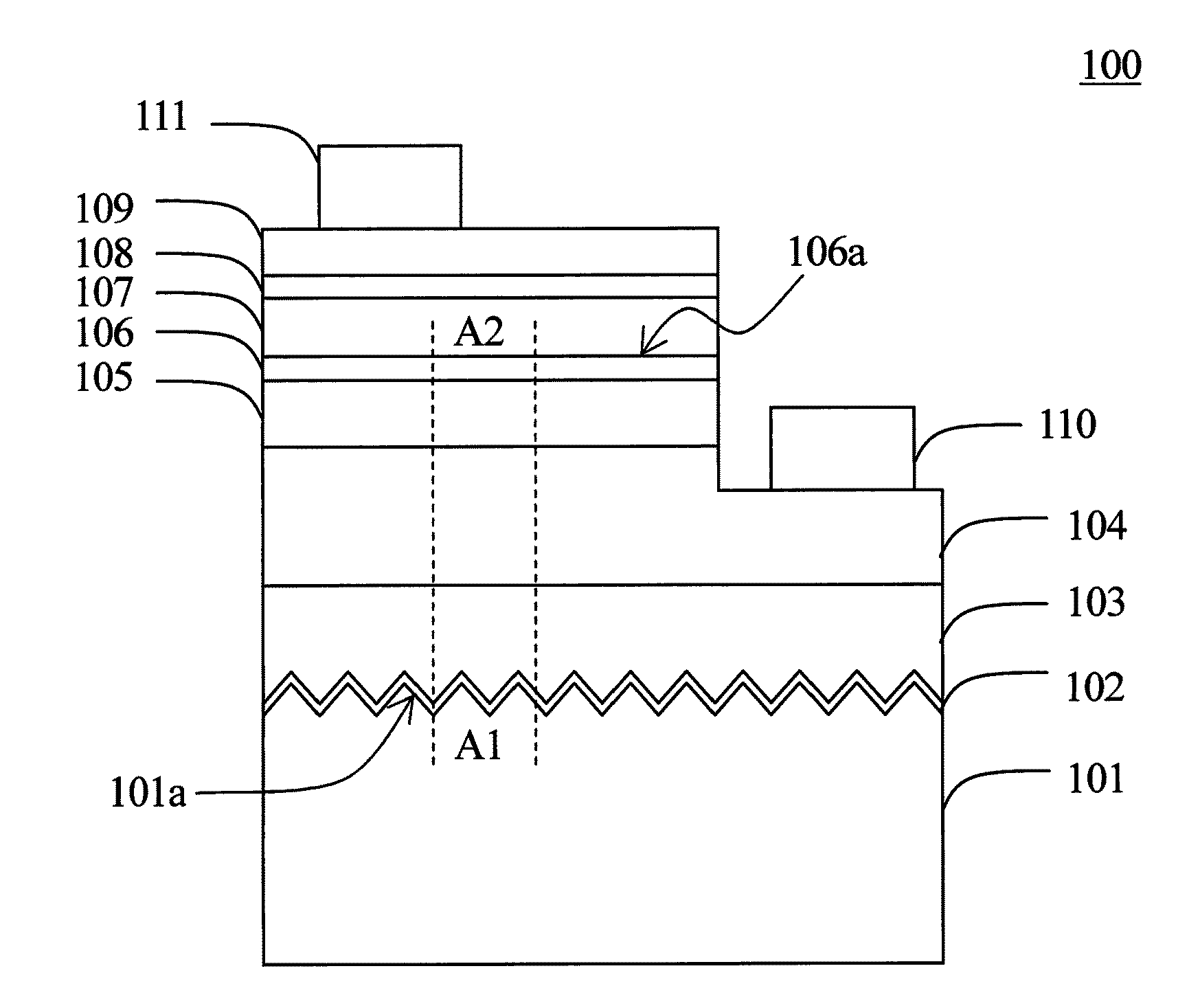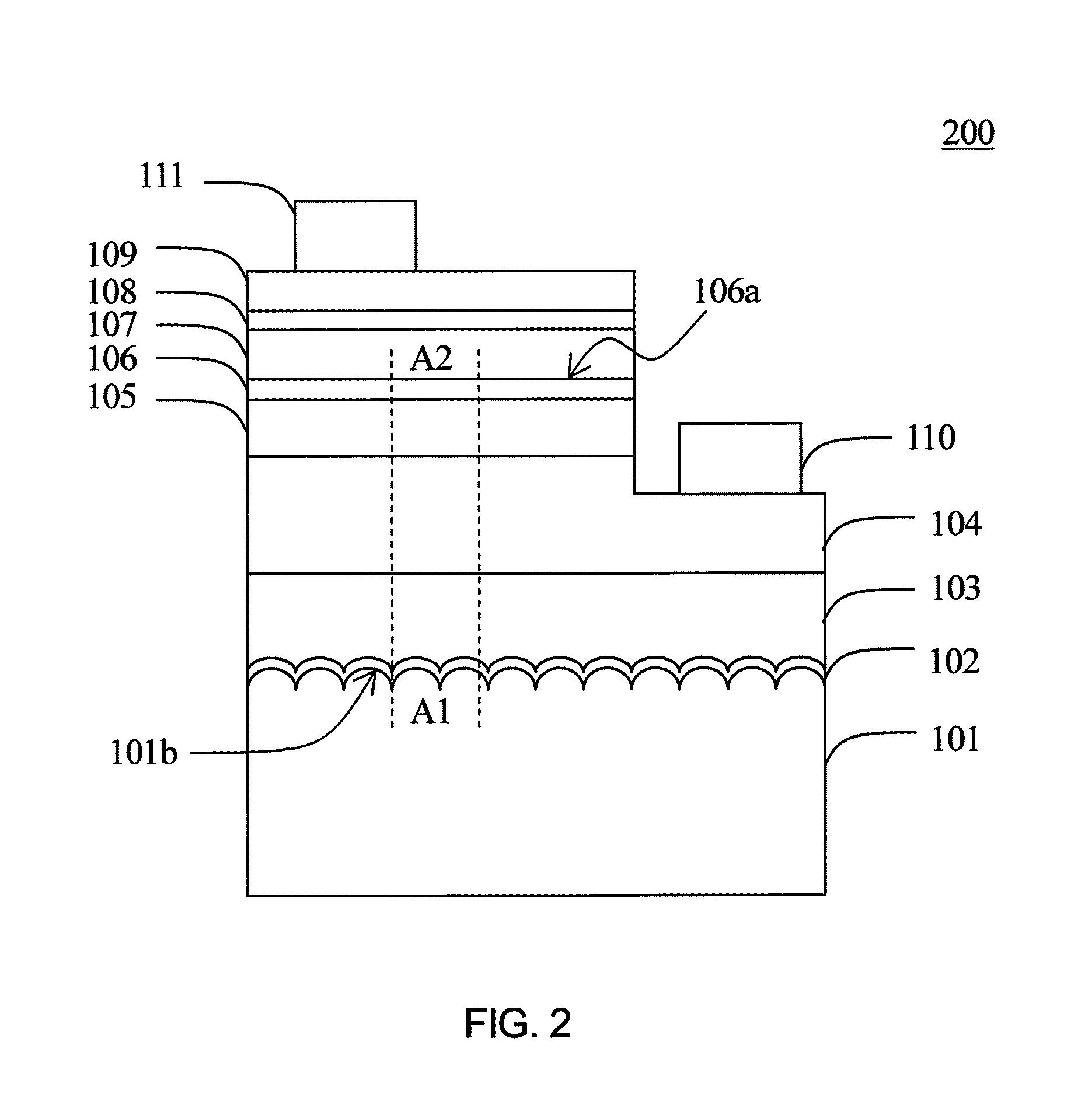Light-emitting device having a patterned surface
a light-emitting device and patterned surface technology, which is applied in the direction of semiconductor devices, basic electric elements, electrical appliances, etc., can solve the problems of affecting the epitaxial quality, affecting the light extraction efficiency and heat dissipation efficiency, and difficulty in subsequently epitaxial growth
- Summary
- Abstract
- Description
- Claims
- Application Information
AI Technical Summary
Benefits of technology
Problems solved by technology
Method used
Image
Examples
first embodiment
[0019]FIG. 1 shows a light-emitting device 100 in accordance with the present disclosure. The light-emitting device 100 comprises a growth substrate 101, an intermediate layer comprising a buffer layer 102 and / or an undoped semiconductor layer 103 epitaxially grown on the growth substrate 101, a first contact layer 104 with first conductivity-type epitaxially grown on the intermediate layer, a first cladding layer 105 with first conductivity-type epitaxially grown on the first contact layer 104, an active layer 106 epitaxially grown on the first cladding layer 105, a second cladding layer 107 with second conductivity-type epitaxially grown on the active layer 106, a second contact layer 108 with second conductivity-type epitaxially grown on the second cladding layer 107, a current spreading layer 109 formed on the second contact layer 108 and forming an ohmic contact with the second contact layer 108, a first electrode 110 formed on the exposed first contact layer 104 by evaporation...
second embodiment
[0020]FIG. 2 shows a light-emitting device 200 in accordance with the present disclosure. In comparison with the light-emitting device 100 shown in FIG. 1, the cross-section of the patterned surface 101b comprises a plurality of ordered patterned units, and each of the patterned units comprises a smooth curve for facilitating the subsequently grown buffer layer 102 and / or the undoped semiconductor layer 103 to fill into the depressed area of the patterned surface 101b. The method for forming the cross-section with a smooth curve comprises firstly forming a mask layer of photoresist on a plane substrate, patterning the mask layer by lithographic process, then curing the patterned mask layer in a baking machine under an appropriate temperature to reflow the patterned mask layer of photoresist to form a profile with smooth curve, finally dry-etching or wet-etching the substrate with the patterned mask layer to transfer the smooth curve profile to the substrate to form a patterned surfa...
third embodiment
[0021]FIG. 3 shows a light-emitting device 300 in accordance with the present disclosure. In comparison with the light-emitting device 200 shown in FIG. 2, the patterned surface 101c of the light-emitting device 300 comprises a plurality of patterned units with variable dimensions or variable patterns disposed in a fixed period, variable period, or quasi-period. The top views of the plurality of the pattern units comprise polygon, or at least one pattern selected from the group consisting of triangle, rectangle, hexagon, and circle. The cross-section of the plurality of pattern units comprises at least two curves with different curvatures.
PUM
 Login to View More
Login to View More Abstract
Description
Claims
Application Information
 Login to View More
Login to View More - R&D
- Intellectual Property
- Life Sciences
- Materials
- Tech Scout
- Unparalleled Data Quality
- Higher Quality Content
- 60% Fewer Hallucinations
Browse by: Latest US Patents, China's latest patents, Technical Efficacy Thesaurus, Application Domain, Technology Topic, Popular Technical Reports.
© 2025 PatSnap. All rights reserved.Legal|Privacy policy|Modern Slavery Act Transparency Statement|Sitemap|About US| Contact US: help@patsnap.com



